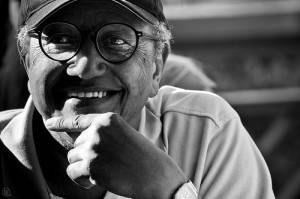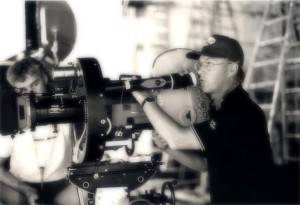
Thinking Animation Book Forewards are written by Floyd Norman and Richard Taylor:
Thinking Animation was so very fortunate to have the book forewords written by Floyd Norman (a traditional 2D artist for Walt Disney Feature and Hanna-Barbera Productions) and Richard Taylor (a director, designer and CG pioneer.)
Floyd Norman – Thinking Animation
 FOREWARD BY FLOYD NORMAN
FOREWARD BY FLOYD NORMAN
The theater was pitch-black as we made our way to our seats. I held my mother’s hand because I couldn’t see a thing in front of me. Once in our seats, I looked up at the towering screen and saw something I’ll never forget. This was no ordinary movie, and the images on the screen were clearly not real. Yet they were hyper-real in a unique kind of way. The motion picture being screened that afternoon was Walt Disney’s Bambi, and it was the first animated cartoon feature I had ever seen. Keep in mind, this was the 1940s, and television had not yet invaded our lives. The only way one saw an animated film was in a theater.
Though only a small child, I knew the images I was watching were colored drawings. Yet these amazing drawings moved with life, had personality, and spoke clever dialogue. What kind of magic was this, I wondered? Whatever it was, this was something I wanted to do. This was something I had to do. That desire to bring life to pencil drawings has never left me. From my first animated scribbles in junior high school to viewing my early test footage at the Walt Disney studio, I continually remain in awe of moving drawings.
Over the years, I’ve been privileged to work with and learn from the best in the business. Masters whose work I enjoyed as a child were generous enough to share their years of experience with me. Yet knowledge can come from the most unlikely of places, so I’ve learned from kids as well as codgers. That’s because we all shared the same passion, and continually searched for ways to improve our art.
This book continues that search, and you’ll find yourself a better animation artist because of it. That blank sheet of pegged paper on your animation desk needn’t engender fear or trepidation because it’s an incredible challenge. It is the opportunity to create, for lack of a better word, magic.
—Floyd Norman (www.afrokids.com/floydsbio.html)
Floyd Norman, Animator and Story Guy
 FOREWARD BY RICHARD TAYLOR
FOREWARD BY RICHARD TAYLOR
This book has been lovingly crafted by two talented animators who enjoy their work and recognize the value of knowing the history, the art, and the craft of animation. Jamie and Angie have pooled the knowledge of some truly talented professionals to help them convey to the artist, animator, historian, or fan the combination of technology, art, discipline, and heart that it takes to succeed as a contemporary animator.
What a phenomenal time this is in the evolution of animation and film. We are surrounded daily by the most complex visual imagery that mankind has ever created; be it in print, movies, television, games, or on the Internet, our lives are bombarded daily by images of seemingly limitless complexity. Today literally any image that a filmmaker can imagine can be realized. True, some dreams cost more than others, but the fact is the tools now exist that allow the artist, the animator, and the filmmaker to create photo-real illusions, fantasy characters that entertain and amaze us in films such as Titanic, The Incredibles, Shrek, Jurassic Park, King Kong, Lord of the Rings, Harry Potter, The Matrix, Alien, Terminator, Blade Runner, Star Wars, and Tron. Films packed with astounding special effects pour out of the studios yearly and on TV weekly. The technological tools to create this imagery are logarithmically improving as they become faster, better, and cheaper annually.
Tron—interesting that I would mention that film. I was a co-visual effects supervisor on the picture, which was released in 1982. Tron was the film that introduced the world to computer imaging. So I’ve been involved with computer animation since its first use in the film industry. I’ve watched as art and technology fused to create the most powerful and limitless visual tool in the history of man.
Computer-generated imaging (CGI) is now the fundamental tool used in creating visual effects and animated features. If there’s one thing I’ve learned over the years, it’s that computers and software don’t create these fantastic images. A computer is analogous to a Steinway piano—it’s an instrument. It’s the artist who plays the instrument who brings it to life.
So how does one become an animator who is adept at the latest technological advances, yet still creates with the spirit and freedom of traditional hand-drawn animation? This book deals directly with that query and should give you plenty of answers.
To begin with, production designers, directors, animators, and other artisans who are legendary in the film industry have several things in common. They know how to draw, they study art and the history of their craft, they hang out with their peers, they are objective, and they make an effort to learn something new every day. But the most essential thing they have in common is self-discipline. Successful artists in painting, photography, music, dance, or animation are joined in an endless dance with their art forms.
They put energy into the process daily, and in return, it teaches them something new. The more you work at an art process, the more it teaches you. This dance is the mother of happy mistakes and magical revelations.
For those who love the art of animation and would like to make animation their life’s work, this book will reveal some basic skills and understandings. Learn to draw 2D animation. The nature of hand-drawn animation allows the animator to exaggerate the elasticity, the personality of a character. Drawing by hand creates a rhythm and flow that’s difficult to achieve in 3D work. It’s the human feeling, the personality, the heart of the animator that can be realized through drawing. Dedicated animators observe the world around them. They constantly watch the way things move; they analyze body language and know that certain gestures convey feelings and emotions. A true animator creates more than anthropomorphic characters; they can bring life, personality, humor, or emotion to anything, be it a teapot, a tree, a lamp, or a chair.
Drawing, I believe, is essential to all the arts, especially the art of animation. The structure, design, and composition of a scene, the gesture of a character, the angle of view, the location, the set, and the props are all created through drawing. Conceptual drawings, storyboard frames, and character studies all seem to start on a napkin or a scrap of paper when an artist quickly sketches an idea before it vanishes. I’m sure you’ve heard the expression, “A picture is worth a thousand words.” In filmmaking and games, thousands of dollars are more like it.
Technology has always affected the arts. Advances in technology spike the creative juices of artists, so it’s inevitable that new ideas, new images, and new animations evolve—images that I like to say “remind you of something you’ve never seen before.” If you really want to be an animator, then begin right now by reading this book. And from this moment on, begin to learn and practice the basic skills of animation and learn to observe and interpret the magic
movements of life.
—Richard Taylor (www.richardtaylordesign.com)
